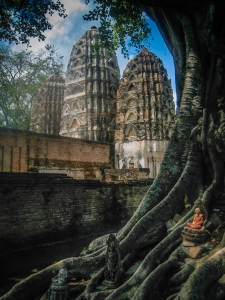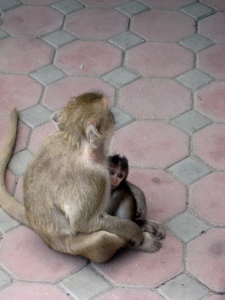Today is Halloween, which means that I’ve been back in the US for just over a year. You wouldn’t know it from this blog, since I’m still mostly writing about my experiences overseas; I can hardly believe it myself! But the dates don’t lie: a year ago today, I was just beginning to deal with the unexpected difficulties of reverse culture shock, and two years ago today, I was teaching Mongolian students and teachers alike about Halloween.
By far the most popular activity of the day was an adaptation of a game I know as “The Winds Are Changing,” which I played with my teacher class. The players stand in a circle, with one in the center, and you mark the spaces in some way – with a playing card, or a pen, or something similar. When I played this at camp, we used it as a get-to-know-you game, and the person in the center had to say their name and something about themselves; on this day, I asked the person in the center to tell the rest of the class something they were scared of. Whether the information being shared is a fear, a fun fact, or an ice cream preference, all other players to whom the fact also applies must leave their spots and find another (one that isn’t adjacent to their own). Because there is one fewer space than there are people and the person in the center is trying to find one of them, there will be a great deal of hustle and bustle as everyone tries not to be left in the center.
Before we began, I provided them with a number of options to choose from: things I thought might be common fears, like heights, public speaking, spiders, snakes, dogs, and cats. I had expected that my students would get a lot of practice saying, “I’m scared of spiders,” and “I’m afraid of cats,” but not much else; up to this point, they’d shown little to no interest in acquiring vocabulary beyond what I provided.
Today was different. I had been asking them questions about themselves all along, but this must have struck a chord, because it wasn’t long before they were asking the more knowledgeable students for more fears to add to the list on the board. By the end of class, they’d appended a number of phrases I never would have thought to give them. Highlights included:
- Yaks – apparently they’re mean
- Thieves and pickpockets
- Police
- Rivers
- Ghosts and evil spirits
- Bad drivers – a legitimate fear in a country with such rudimentary roads and driving instruction!
- The dark
Midway through the class, we got an unexpected and unorthodox addition. My roommate, finding herself in the hot seat without a prepared statement, shouted, “I’m scared of Bayasmaa!” The room erupted in laughter, and everyone but Bayasmaa – the school’s physical education teacher, to whom I had assigned the dragon icon in my phone contacts list – scurried to change places.
The best, though, came at the very end of the class period. One of the teachers clearly had something in mind, and when none of the others could translate it for her, she pulled out a dictionary and went hunting. At this point, only I was in the dark as to what she was trying to express, but I knew it had to be good from how anxiously all the other teachers were waiting.
Finally, she grinned in triumph, set the dictionary down, and returned to her space in the center of the circle.
“I’m scared of mother-in-law!” she crowed, and the room erupted in chaos as everyone, even the unmarried teachers, abandoned their spaces and caromed off each other in search of new ones.
Some fears, I guess, are universal.


















 Even there, we weren’t entirely safe. The fence was there to keep the tourists out; it did nothing whatsoever for the monkeys. They were everywhere in this part of the town: roaming the streets, lazing on the sidewalks, walking the power lines, even invading some of the ground-floor stores. I snapped a few pictures of the admittedly adorable babies but quickly discovered what the locals already know: they are clever, mischievous pests, made all the more pestilential by their intelligence and opposable thumbs. What I really wanted was a monkey stick, one of those long bamboo rods the shopkeepers used to to keep the macaques at bay without coming in range of their teeth. Lacking such a device, I tread amongst them with care. Never have I been so aware of my lack of a rabies vaccination as I was as I made my slow way through the monkey gauntlet, doing my utmost not step on anyone’s tail.
Even there, we weren’t entirely safe. The fence was there to keep the tourists out; it did nothing whatsoever for the monkeys. They were everywhere in this part of the town: roaming the streets, lazing on the sidewalks, walking the power lines, even invading some of the ground-floor stores. I snapped a few pictures of the admittedly adorable babies but quickly discovered what the locals already know: they are clever, mischievous pests, made all the more pestilential by their intelligence and opposable thumbs. What I really wanted was a monkey stick, one of those long bamboo rods the shopkeepers used to to keep the macaques at bay without coming in range of their teeth. Lacking such a device, I tread amongst them with care. Never have I been so aware of my lack of a rabies vaccination as I was as I made my slow way through the monkey gauntlet, doing my utmost not step on anyone’s tail. In all respects but one, though, I made my way through the city without incident. My bandaged hand drew a lot of attention throughout the day, and I found myself continually having to explain that it was not (thankfully!) from a monkey bite. The nurses at the clinic I visited in the afternoon were among those who asked the question. I’d been instructed to have the bandages on my hand rewrapped every day, and while that seemed like overkill, the sheer difficulty of keeping the gauze clean and neat convinced me to have it done at least on that first day.
In all respects but one, though, I made my way through the city without incident. My bandaged hand drew a lot of attention throughout the day, and I found myself continually having to explain that it was not (thankfully!) from a monkey bite. The nurses at the clinic I visited in the afternoon were among those who asked the question. I’d been instructed to have the bandages on my hand rewrapped every day, and while that seemed like overkill, the sheer difficulty of keeping the gauze clean and neat convinced me to have it done at least on that first day.



